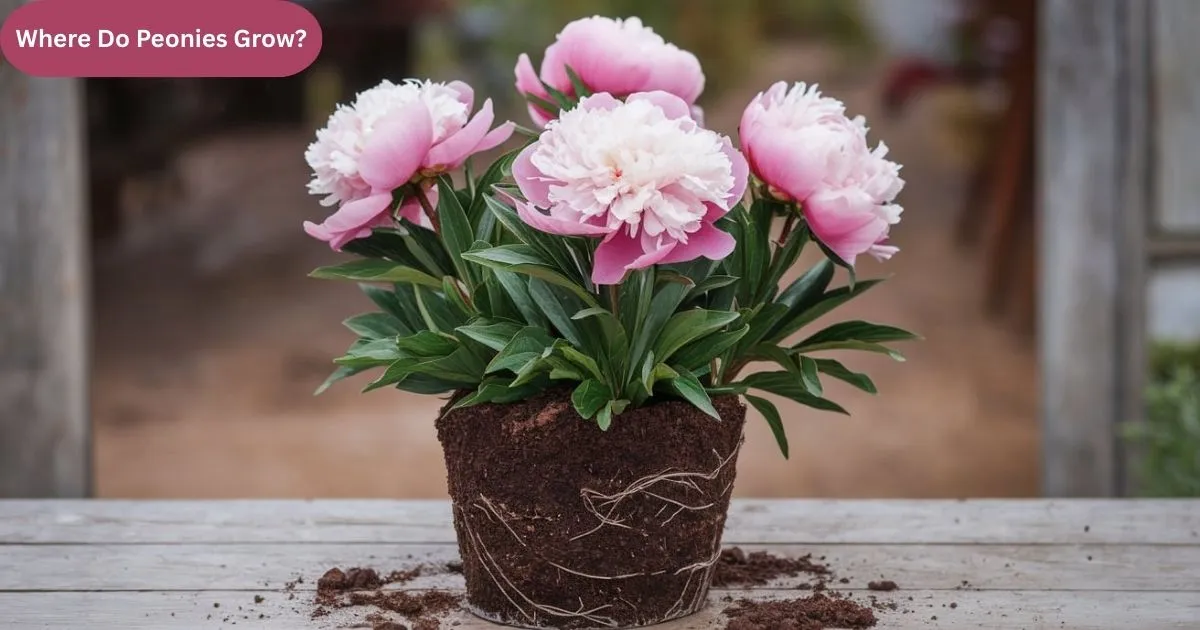Peonies are beloved for their large, fragrant blooms and vibrant colors, making them a favorite in gardens and floral arrangements. These perennial flowers are known for their beauty and can thrive for many years with proper care. However, to ensure that peonies grow healthily and bloom abundantly, it’s important to understand the best environments for them.
Whether you’re a seasoned gardener or a beginner, knowing where peonies grow best will help you create the ideal conditions. From selecting the right location to preparing the soil, understanding these key factors can lead to a flourishing garden filled with stunning peony flowers.
Read More: When to Separate Peonies
Peony Growth Regions
Peonies grow best in regions with distinct seasons. They need cold winters to trigger dormancy, which helps them bloom in spring. The ideal climate is temperate, where winters are cold, and summers are warm but not too hot.
They grow well in areas with hardiness zones 3 to 8. These zones include parts of North America, Europe, and Asia. Areas with mild winters and moderate summers are perfect for peony growth. This is why they are common in regions like the Midwest and Northern Europe.
The Importance of Climate
Climate plays a big role in how well peonies grow. They prefer regions with long, cold winters and not extreme heat. In hot climates, peonies might struggle, and their blooms may not be as vibrant.
A mild spring and summer are ideal. Peonies need a period of cold to grow properly. Too much heat can stress the plant and affect its flowering ability. The right climate ensures strong stems and beautiful blooms.
Soil Requirements for Peonies
Peonies prefer well-drained, fertile soil. The soil should be slightly acidic to neutral, with a pH level between 6.5 and 7.0. It should also have a good amount of organic matter to provide nutrients.
The soil must be well-draining because peonies don’t like to sit in water. Waterlogged soil can lead to root rot. To improve soil drainage, gardeners often mix compost or organic matter to create an ideal growing environment for peonies.
Best Garden Locations for Peonies
Peonies thrive in sunny locations. They need at least six hours of direct sunlight each day. A sunny spot helps the plant to bloom fully and ensures strong growth.
Choose a location that is sheltered from strong winds. Strong gusts can damage the tall, heavy flowers. Planting peonies near a fence or a building can provide the necessary protection while ensuring they receive full sunlight.
Peonies in Different Climates
While peonies grow best in temperate climates, some varieties can adapt to different environments. For example, tree peonies can handle slightly warmer temperatures than herbaceous peonies. They can tolerate milder winters but still need cool periods to thrive.
In colder climates, peonies grow in areas with snow cover, which insulates their roots during winter. In warmer areas, peonies may need extra care, such as planting in shaded areas or using mulch to protect the roots during hot weather.
How to Grow Peonies in Your Area
To successfully grow peonies, it’s important to know your local climate and soil conditions. If you live in an area with cold winters, peonies will likely grow without much effort. However, in warmer regions, you may need to take extra steps.
Ensure your soil is well-drained and rich in organic material. You can amend the soil by adding compost or peat moss. Plant your peonies in a location with plenty of sunlight and space for their roots to spread out.
Peony Care and Maintenance
Peonies are low-maintenance flowers, but they do need some care to grow well. Water your peonies regularly, especially during dry periods. However, avoid overwatering, as peonies do not like their roots to be constantly wet.
Fertilize peonies in early spring before they begin to grow. Use a balanced fertilizer to promote healthy blooms. Deadhead spent flowers after blooming to encourage more growth. Additionally, protect peonies from pests like ants or aphids, which can sometimes damage the plants.
Peonies in Containers
If you live in an area where the soil is not ideal, or you don’t have a garden, you can still grow peonies in containers. Choose a large, deep pot that allows the roots to grow comfortably. Use well-draining potting soil and ensure the pot has drainage holes.
Place the container in a sunny spot that gets at least six hours of sunlight a day. While container-grown peonies may not grow as large as those planted in the ground, they can still produce beautiful flowers. Make sure to water them properly and protect them from extreme heat.
Conclusion
In conclusion, peonies are versatile and resilient flowers that can thrive in a variety of climates, provided they have the right conditions. They grow best in temperate regions with cold winters and mild summers, in well-drained, fertile soil with plenty of sunlight. Proper care, including regular watering, fertilizing, and protecting from extreme heat, is essential for their health.
Whether planted in the ground or in containers, peonies can add stunning beauty and fragrance to gardens and homes. With the right environment and attention, these flowers will flourish and reward gardeners with breathtaking blooms year after year.
FAQ’s
What is the best climate for growing peonies?
Peonies thrive in temperate climates with cold winters and mild summers.
How much sunlight do peonies need?
Peonies need at least six hours of direct sunlight daily.
Can peonies grow in containers?
Yes, peonies can grow in large containers with well-draining soil.
How often should I water my peonies?
Water peonies regularly, but avoid overwatering to prevent root rot.
What type of soil do peonies prefer?
Peonies prefer well-drained, fertile soil with a slightly acidic to neutral pH.









